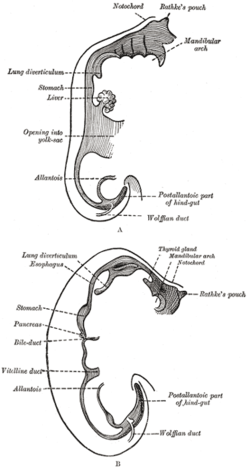- Vitelline duct
-
Vitelline duct Fetus of about eight weeks, enclosed in the amnion. (Vitelline duct labeled at lower right.) Sketches in profile of two stages in the development of the human digestive tube. (Vitelline duct labeled on bottom image.) Gray's subject #10 54 Days 28 Precursor midgut, yolk sac MeSH Vitelline+Duct In the human embryo, the vitelline duct, also known as the omphalomesenteric duct, is a long narrow tube that joins the yolk sac to the midgut lumen of the developing fetus.[1] It appears at the end of the fourth week, when the yolk sac presents the appearance of a small pear-shaped vesicle (the umbilical vesicle).
Contents
Obliteration
Generally, the duct fully obliterates (narrows and disappears) during the 7th week of fertilization age (9th week of gestational age), but a failure of the duct to close is termed a vitelline fistula. This results in discharge of meconium from the umbilicus.[2] About two per cent of fetuses exhibit a type of vitelline fistula characterized by persistence of the proximal part of the vitelline duct as a diverticulum protruding from the small intestine, Meckel's diverticulum, which is situated about two feet above the ileocecal junction and may be attached by a fibrous cord to the abdominal wall at the umbilicus.
Afterbirth
The vesicle can be seen in the afterbirth as a small, somewhat oval-shaped body, the diameter of which varies from 1 mm to 5 mm. It is situated between the amnion and the chorion and may lie on or at a varying distance from the placenta.
Sometimes a narrowing of the lumen of the ileum is seen opposite the site of attachment of the duct.
Mnemonic
A mnemonic used to recall details of a Meckel's diverticulum is as follows: "2 inches long, 2 feet from ileocecal valve, 2% of population, 2% symptomatic, 2 types of ectopic tissue: gastric and pancreatic."
Additional images
External links
- yolk+stalk at eMedicine Dictionary
Embryonic adnexa Trophoblast (Cytotrophoblast, Syncytiotrophoblast, Intermediate trophoblast)
Chorionic villi/Intervillous space · Amnion/Amniotic sac/Amniotic cavity
rostral embryonic ligament · caudal embryonic ligamentFetal membranes Circulatory Ungrouped References
- ^ Le, Tao; Bhushan, Vikas; Vasan, Neil (2010). First Aid for the USMLE Step 1: 2010 20th Anniversary Edition. USA: The McGraw-Hill Companies, Inc.. pp. 122. ISBN 978-0-07-163340-6.
- ^ Le, Tao; Bhushan, Vikas; Vasan, Neil (2010). First Aid for the USMLE Step 1: 2010 20th Anniversary Edition. USA: The McGraw-Hill Companies, Inc.. pp. 122. ISBN 978-0-07-163340-6.
Categories:
Wikimedia Foundation. 2010.



